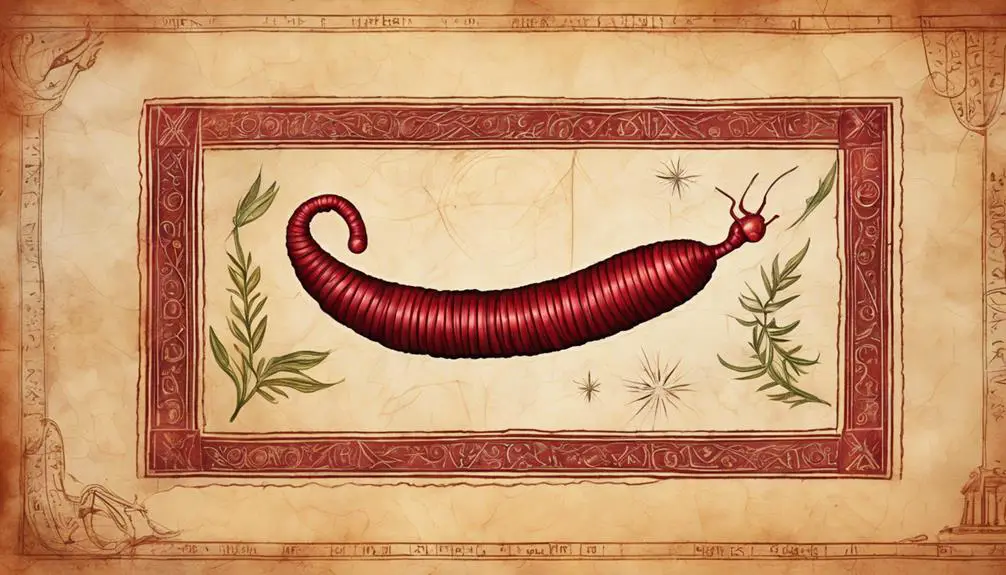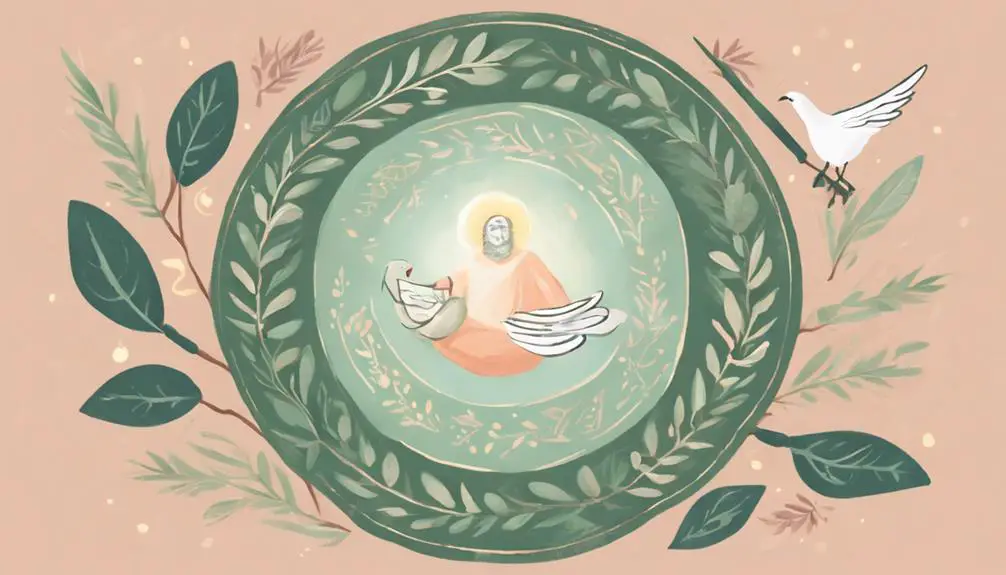An exploration of the humble tola worm's surprising biblical significance awaits, challenging traditional interpretations and sparking curiosity.

Tola Worm in the Bible
You've likely walked past a thousand tola worms without giving them a second thought, but in the Bible, these humble creatures carry an enormous symbolic weight.
Ever wondered why? As a tiny, seemingly insignificant organism, it's fascinating to consider why the Bible might choose to highlight such a creature.
The answer lies hidden in the ancient texts, waiting for you to uncover. This unexpected journey into biblical interpretation promises to challenge your preconceptions.
So, are you ready to embark on this intriguing exploration of the tola worm's biblical significance?
Key Takeaways
- The Tola Worm symbolizes humility, self-sacrifice, sin, purification, and divine mercy in the Bible.
- Its life cycle mirrors themes of transformation, rebirth, and resilience, offering valuable metaphors for human life.
- Scholarly debates revolve around the Tola Worm's origin, biblical accuracy, and its role in authenticating biblical texts.
- The Tola Worm serves as a profound metaphor in the Bible, embodying themes of humility, self-sacrifice, and resurrection.
Understanding the Tola Worm

To fully grasp the significance of the Tola Worm in biblical context, it's essential to first understand its characteristics and symbolic representation. The Tola Worm, also known as the scarlet worm or crimson worm, is a small, unassuming creature. Yet, its importance can't be understated. It's a symbol of humility, insignificance, and lowliness, often used metaphorically in the scriptures.
The worm's life cycle is unique and carries deep symbolism. The female attaches herself to a tree or a wooden surface, creating a hard, crimson shell, under which she lays her eggs and dies. Her body and the shell then turn into a bright scarlet fluid, staining the wood and her offspring. This process, a symbol of self-sacrifice, is intrinsically tied to Tola's significance.
Therefore, the worm's symbolism isn't just about humility or lowliness, but also about sacrifice and transformation. This understanding provides a deeper insight into the biblical context wherein the Tola Worm is referenced. It shapes the way you perceive the worm's significance, and consecutively, the biblical text that mentions it.
Biblical References to Tola Worm

Now that you're familiar with the symbolic significance of the Tola Worm, let's explore its notable mentions in biblical texts. The Tola Worm's habitat, typically envisioned as rotting wood or earth mounds, serves as an intriguing backdrop to its Bible references, adding a unique depth to its mentions.
Let's consider three impactful biblical references where the Tola Worm's significance shines through:
- The first mention is found in Isaiah 1:18, where the Tola Worm's crimson color symbolizes sin, but also the possibility of purification.
- In the book of Jonah (4:7), a worm, often interpreted as a Tola Worm, plays a crucial role in teaching Jonah about compassion and divine mercy.
- Finally, in Psalm 22:6, the speaker identifies himself as a worm and not a man, which scholars believe may be a reference to the Tola Worm, signifying humility and insignificance.
Each of these passages utilizes the Tola Worm as a powerful metaphor. Its habitat, color, and characteristics are leveraged to deliver profound messages, demonstrating the Tola Worm's significant role in biblical texts.
Tola Worm's Symbolic Meaning

Diving deeper into the symbolic meaning of the Tola Worm, you'll find it's often used as a powerful metaphor in biblical texts, representing themes such as sin, purification, humility, and divine mercy. The worm's significance goes beyond its physical appearance, embodying profound spiritual notions that bear relevance in theological discussions.
Consider the worm's life cycle, which in itself, is symbolic. Its transformation from a seemingly insignificant creature into a vibrant, crimson moth mirrors the spiritual journey of believers from sin and degradation to redemption and glory. This metamorphosis also echoes the biblical promise of resurrection and new life.
This brings us to symbolic colors. The Tola Worm is predominantly red, a color deeply significant in biblical texts. Red often symbolizes sin, but it's also the color of the blood shed for the remission of sin. The color of the Tola Worm, therefore, encapsulates the paradox of sin and redemption.
Similarly, the humility of the worm, considered the lowest among creatures, conveys the Christian virtue of humility. As the Bible encourages believers to humble themselves, the Tola Worm serves as a potent symbol of this edict.
Scholars' Interpretations of Tola Worm

Let's turn our attention to how scholars have interpreted the significance of the Tola Worm in biblical texts. The Tola Worm's origin and its biblical accuracy have been subjects of scrutiny and debate among scholars.
Primarily, scholars have considered the Tola Worm in two main perspectives:
- Some trace the Tola Worm's origin back to ancient Israel, associating it with the crimson or scarlet worm, a specific species that exhibits unique behaviors paralleling biblical symbolism. These scholars assert that the biblical accuracy in depicting the Tola Worm reflects an advanced understanding of nature, contributing to the authenticity of biblical texts.
- Others argue that the Tola Worm's origin may have been misinterpreted due to translation errors. They suggest that 'Tola' could refer to various species of worms, and not necessarily the crimson one. This interpretation raises questions about biblical accuracy.
Lessons From the Tola Worm

Turning our focus to the lessons derived from the Tola Worm, it's fascinating to analyze how this seemingly insignificant creature holds profound messages and insights within biblical context.
The Tola Worm, in its humble form, offers a wealth of Worm Metaphors that are significantly applicable to human life. The transformation of a worm into a butterfly symbolizes the idea of rebirth and new beginnings, which is a recurring theme in the Bible. This concept teaches you that despite the struggles and challenges you may face, there's always the potential for growth and transformation.
Moreover, the Tola Worm carries Prophetic Implications. It's described as silent and uncomplaining, despite its suffering. This can be viewed as a metaphor for the trials humans undergo, and the strength and silent resilience required in the face of adversity.
Additionally, the crimson color of the Tola Worm, which was used in dyeing royal garments, suggests the idea of nobility and sacrifice. This serves as a reminder of the intrinsic worth and potential within each individual, regardless of their current circumstances.
In essence, the Tola Worm offers valuable lessons about transformation, resilience, and inherent value, shedding light on profound biblical teachings.
Frequently Asked Questions
What Is the Scientific Identification of the Tola Worm Mentioned in the Bible?
You're asking about the scientific identification of the 'tola worm' from biblical texts. It's not straightforward, as religious texts often use symbolism and metaphors. 'Tola' mightn't refer to a specific species, but instead carry symbolic weight.
It's reported to symbolize humility or insignificance, fitting the use of worm metaphors. So, it's less about identifying an exact species, and more about understanding the symbolic language used.
Are There Any Cultural or Historical Significance of the Tola Worm Outside of Biblical Contexts?
Yes, there's cultural and historical significance to the Tola worm beyond the Bible. It's often seen as a symbol of resurrection and transformation in different cultures.
Non-biblical references use the Tola worm symbolism to signify endurance and hope, as it endures hardship before transforming into a beautiful creature.
Were There Any Specific Events or Stories in the Bible Where the Tola Worm Played a Significant Role?
You're asking about specific events or stories where worm metaphors played a significant role.
In biblical symbolism, worms often represent death and decay. However, the 'tola' worm, or crimson worm, is seen differently.
It's mentioned in Psalms 22:6, where David uses it metaphorically to express his feelings of insignificance and degradation.
This instance is particularly important due to its symbolic representation of Christ's suffering and resurrection.
How Is the Tola Worm Represented or Perceived in Different Translations or Versions of the Bible?
When looking at different translations of the Bible, you'll see varied interpretations of the tola worm's symbolism. Some versions depict it as a metaphor for humility and suffering, while others use it to represent rebirth and transformation.
It's fascinating to see how these biblical metaphors can be perceived differently, and it's up to you to delve deeper into the texts to discern its true meaning.
Are There Any Artistic or Literary Works Inspired by the Tola Worm From the Bible?
You're seeking artistic or literary works inspired by the worm symbolism in the Bible, right?
Yes, there are. The worm symbolism in art and biblical creatures in literature have sparked much creativity. Some artists and authors use the humble worm to depict themes of mortality, transformation, and resilience, drawing from its biblical representation.
These works span various mediums and genres, making the worm a surprisingly profound symbol in the world of arts and literature.
Conclusion
You've now delved into the significance of the Tola Worm in the Bible. This creature, often overlooked, carries profound symbolic meaning. Scholars interpret its presence as a symbol of humility, transformation, and resilience.
By understanding the Tola Worm, you gain a fresh perspective on biblical narratives. Remember, even the smallest, seemingly insignificant details can hold lessons, much like the humble Tola Worm.


Sign up